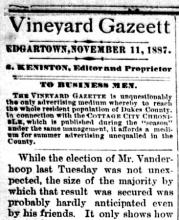The Wampanoag Tribe will receive the remaining skeleton of a dead juvenile humpback whale that washed up on Squibnocket Beach on Monday.
Matthew (Cully) Vanderhoop, natural resource director for the Wampanoag Tribe of Gay Head (Aquinnah), said the skeleton will be put on exhibit at some future date in the tribe’s planned cultural center. He and a large team of scientists and volunteers spent much of yesterday cutting up the carcass and removing it from the beach.
After the 32-foot male humpback beached, police were notified and within a short time hundreds of Vineyarders came to the beach. State environmental police Sgt. William L. Searle estimated that in just 24 hours more than 1,500 people, including schoolchildren, had made the trek to see the whale. A dozen federal and state scientists also came to Squibnocket. On Wednesday, scientists performed a necropsy in an attempt to gather information about the whale and the cause of its death.
Scientists estimated the whale was two or three years old and had been dead for more than two weeks. Cause of death is unknown, according to Connie Merigo, on-site coordinator for the New England Aquarium marine animal rescue team.
Miss Merigo said photographs were taken of the whale’s tail in an effort to identify the animal. With the science of monitoring whales now so comprehensive, experts have been keeping records on many of the gigantic ocean creatures. She said it is very likely that this whale is known.
At the edge of the Squibnocket shoreline, Miss Merigo was with a dozen volunteers and staff, and some of the scientists were with the Cape Cod Stranding Network of the National Marine Fisheries Service. One of the scientists was Tom French of the Massachusetts Division of Fisheries and Wildlife. He is the assistant director of the Natural Heritage and Endangered Species Program and took charge of the salvage team yesterday.
Mr. Vanderhoop said he spoke to Mr. French about acquiring the carcass for the tribe. “He told me that they would have liked to leave it local if possible. I told him about our plans for a cultural center,” Mr. Vanderhoop said.
In just a few days, word of the dead whale on the beach traveled across the Island. Students from the Martha’s Vineyard Public Charter School, the Menemsha School and the Tisbury School made visits to the site.
“I’ve never seen a humpback whale before,” said Byron Kennedy, 9, a fourth grader at the Tisbury School. On Wednesday, he stood with his classmates up close to the police line.
Students were shown how the whale could be identified, how a humpback whale usually has white flippers and a mostly white tail. The whale was on its back. Huge barnacles were attached along the mouth of the creature.
Police and scientists took pains to caution the public to leave the whale alone. Sergeant Searle said that even a dead whale is highly protected, and under federal and state laws no one is permitted even to touch a whale. Fines start at $500.
Miss Merigo said: “Like any dead animal, whales can carry a virus or a disease that can be harmful to humans if you touch it. We don’t know why it died, whether it was some disease.” All of the scientists worked wearing latex rubber gloves.
By Wednesday at noon, the scientists had opened the whale. Dr. Michael Moore, a researcher at the Woods Hole Oceanographic Institution and a lead veterinarian for the Cape Cod Stranding Network, said the animal must have been dead for at least two weeks, as all the vital organs of the creature had deteriorated considerably. Anyone downwind smelled the rotting carcass.
Teri Frady of the National Marine Fisheries Service said adult humpback whales grow to be 40 to 50 feet in length. “Young are gestated for about 11 months and at birth are about 12 feet long, weighing about a ton. Humpbacks are common to Vineyard waters. They feed for six to nine months of the year and then fast for the remaining months.
More and more whales are washing up on area beaches as the species makes a slow recovery in this area. On the Vineyard, a finback whale washed up on Norton Point in Edgartown in 1996. A 40-foot humpback whale washed up on South Beach in 1992. A 50-foot humpback whale washed up on a Chilmark beach in 1991.
Protecting the whale from poachers proved to be a challenge Tuesday night. Capt. W. Russell Webster of Group Woods Hole said Coast Guardsmen from Menemsha Station were called in to relieve tired local police, especially when it became apparent that poachers wanted pieces of the whale.
Late at night, Captain Webster said, “People were pretty aggressive in trying to get portions of the leviathan.” Federal and state laws are severe if someone is caught.
Mr. Vanderhoop said pieces of the whale will be used for educational purposes at the new cultural center to be built for the tribe. Yesterday, crews worked hard to remove the bones of the whale for safekeeping. “We will cure the bones,” he said. “Hopefully the skeleton will hang up in our cultural center. This is a great opportunity for us. We are in the planning stages of making our cultural center and this will be a fantastic piece, hung somewhere in the center.”









Comments